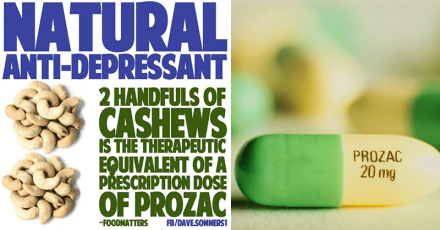Two handfuls of cashews is the therapeutic equivalent of a prescription dose of Prozac. Inside you, the essential amino acid L-tryptophan is broken down into anxiety-reducing, snooze-inducing niacin. Even more important, tryptophan is also made into serotonin, one of your body’s most important neurotransmitters. Serotonin gives a feeling of well-being and mellowness, or as the Australians would say, “no worries.” This is such a profound effect that Prozac, Paxil and similar antidepressants usually either mimic serotonin or artificially keep the body’s own serotonin levels high. You can do the same thing with your food. And no one can tell us that beans, peas, cheese, nuts and wheat germ are toxic if you eat a lot of them! Plenty of carbohydrates (starches) in your meals help tryptophan get to where it does the most good: in your brain. In order to cross the blood-brain barrier to get in, carbos are required. So cheese and crackers provides a better effect than the cheese standing alone. An egg or two on toast is better than just the egg. Beans, peas, and nuts already contain carbohydrate, so you are all set there. Consider that five servings of beans, a few portions of peanut butter, or just one big handful of cashews provides one to two thousand milligrams of tryptophan, which will work as well as prescription antidepressants… but don’t tell the drug companies. Some skeptics think that the pharmaceutical people already know. Here are two quotes in evidence: “Pay careful attention to what is happening with dietary supplements in the legislative arena… If these efforts are successful, there could be created a class of products to compete with approved drugs. The establishment of a separate regulatory category for supplements could undercut exclusivity rights enjoyed by the holders of approved drug applications.” (Source: FDA Deputy Commissioner for Policy David Adams, at the Drug Information Association Annual Meeting, July 12, 1993) Here are 15 other Amazing Health Benefits Of Cashew Nuts Who doesn’t know about cashew nuts? Caju is what we call them in India. We use them mostly in sweets and children love to eat them as they are. They are full of anti-oxidants, vitamins and minerals which are required for the normal functioning of the body. They actually belong to Brazil but Portuguese brought them to India in the 16th century. The kidney shaped or bean shaped nuts have many health benefits, a few of which are presented below: 1. Prevents Cancer: Proanthocyanidins are a class of flavonols which fight against tumor cells by stopping them to divide further. These proanthocyanidins and high copper content in cashew nuts help fight against cancerous cells and keeps you away from colon cancer. This is one of the major cashew nut benefits. 2. Healthy Heart: Cashews contain low fat content when compared to other nuts and that too in the oleic acid form which is very healthy for heart. They are cholesterol free and the antioxidants present keeps you away from heart diseases. 3. Lowers High Blood Pressure: Cashew nuts lower your blood pressure with the help of magnesium present in them. 4. Helps Hair: Copper is the mineral which helps your hair get that color. So if you take cashews which are full of copper content, you can get that black hair that you always wished for. 5. Healthy Bones: Like calcium, magnesium is also important for bone health which is the main content in cashew nuts. 6. Healthy Nerves: Magnesium is stored on the bones surface which prevents calcium from entering the nerve cells and thus keeps the blood vessels and muscles relaxed. Insufficient amount of magnesium can lead calcium to enter the blood vessels leading them to contract. It also leads to high blood pressure, migraine headache etc. 7. Prevents Gallstones: Daily intake of cashewnut can reduce the risk of developing gallstones up to 25%. 8. Helps in Weight Loss: Even though cashew nuts are considered as fats, it contains good cholesterol. So contrary to popular belief, those who eat cashews at least twice a week gain less weight when compared to those who eat less. 9. Anti-oxidants: Selenium, copper, magnesium etc. act as co-factors for many enzymes. 10. Helps Digestion: Cashew nuts help in growth and development, nucleic acid synthesis and digestion. 11. High on Vitamins: Cashew nuts are rich in vitamins like riboflavin, pantothenic acid, thiamin, niacin etc. These vitamins keep you safe from sideroblastic anemia, pellagra, etc. 12. Healthy Gums and Teeth: As mentioned before, the magnesium content present in cashew nuts is very good for bones. So it gives healthy teeth as well as strong gums to hold them. 13. Pleasant sleep: After menopause, these cashew nuts can give you relaxed and pleasant sleep during nights. 14. Free Radicals: Cashew nuts help our body to utilize iron properly and eliminate free radicals which cause health problems. 15. Macular Degeneration: Cashew nuts have the ability to filter Sun’s UV rays and protect us from macular degeneration. Now that you know the health benefits of Cashew nuts, ensure that you eat a few once every week I am sure you already love them.










